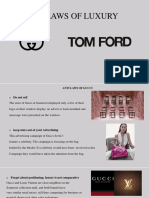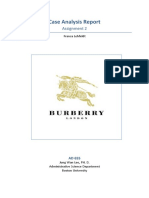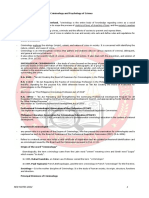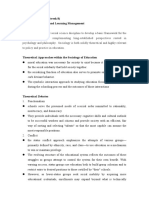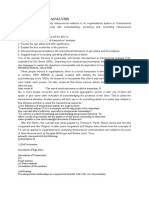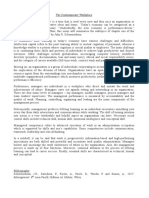Burberry Case Study About Consumer Behavior: By: Chenoy Ceil
Burberry Case Study About Consumer Behavior: By: Chenoy Ceil
Uploaded by
Jilda KayaCopyright:
Available Formats
Burberry Case Study About Consumer Behavior: By: Chenoy Ceil
Burberry Case Study About Consumer Behavior: By: Chenoy Ceil
Uploaded by
Jilda KayaOriginal Title
Copyright
Available Formats
Share this document
Did you find this document useful?
Is this content inappropriate?
Copyright:
Available Formats
Burberry Case Study About Consumer Behavior: By: Chenoy Ceil
Burberry Case Study About Consumer Behavior: By: Chenoy Ceil
Uploaded by
Jilda KayaCopyright:
Available Formats
Burberry Case Study about Consumer Behavior
By: Chenoy Ceil
Electronic copy available at: https://ssrn.com/abstract=3520418
Executive Summary
Consumer behavior is an essential part of the marketing for brands that are trying to influence the
purchasing behavior of consumers. Burberry as a brand has been able to influence the purchase
decisions of consumers by utilizing motivational, perception, personality and lifestyle strategies.
This paper looks at the various factors that are utilized by Burberry that act as marketing
stimulus for influencing the purchasing decision of their consumers. Some recommendations
dealing with the brand perception of Burberry are also provided to help Burberry improve their
sales and create a unique fashion brand for itself. Motivation, personality and emotion are
important factors that affect consumer decision making, especially in the case of high fashion
products. Looking at all these various factors in detail, this paper concludes that motivation,
perception, personality and lifestyle have been carefully utilized by Burberry to reposition its
brand for the modern age.
Electronic copy available at: https://ssrn.com/abstract=3520418
Table of Contents
Executive Summary ....................................................................................................................................... 2
1. Introduction ............................................................................................................................................... 4
2. How Burberry uses Motivational Theories ............................................................................................... 5
3. How Burberry uses Perception Theories .................................................................................................. 6
4. How Burberry uses Personality Theories .................................................................................................. 8
5. How Burberry uses Lifestyle Theories ..................................................................................................... 9
6. Recommendations and Conclusion ......................................................................................................... 12
References ................................................................................................................................................... 13
Appendix ..................................................................................................................................................... 15
Appendix A: Burberry Strategy ............................................................................................................... 15
Electronic copy available at: https://ssrn.com/abstract=3520418
1. Introduction
Understanding consumer behavior in the 21st century requires a close understanding of how
consumers have evolved in the digital age. Consumer behavior is the study of how consumers
make, select, dispose or purchase ideas, products, services or experiences to satisfy their needs
and desires (Solomon, 2017). Consumers and customers are the end users or buyers of the goods
and services, and to study what influences their decisions is important for business to thrive and
grow (Noel, 2009).
Luxury brands and the concept of luxury fashion brands have exploded internationally in the last
20 years (Balmer and Burghausen, 2015). Burberry as a luxury brand was started in the year
1856 by Thomas Burberry and it soon became eponymous as a luxury brand. The first store of
Burberry opened in the year 1891 in Haymarket, London (Robins and Ricca, 2012).
Headquartered in London, Burberry designs, manufactures and sells ready to wear clothes and
accessories that are built on innovation and luxury.
This paper looks at how consumer goods are purchased and utilized by consumers and what
motivations drive the consumer behavior. Looking specifically at the luxury brand Burberry, the
analysis is made of how Burberry uses motivational, perception, personality, and lifestyle
theories to drive consumers towards the brand. Marketing’s impact on consumers is immense in
driving the perception of the brand and Burberry has been able to utilize various strategies to
market the brand effectively.
Electronic copy available at: https://ssrn.com/abstract=3520418
2. How Burberry uses Motivational Theories
Burberry as a brand represents the clean, British style of traditional apparel with clean looks and
high-quality material (Noel, 2009). The brand has strengthened itself as a luxury brand with its
indistinguishable pattern and celebrity endorsements that have helped the brand become globally
recognized (Peng and Chen, 2012).
Motivation is often described as an energizing force that activates certain behaviours influencing
decision making (Peng and Chen, 2012). Motivation theories range from genetic biological
approaches to needs-based approach towards consumer behavior. Maslow forwarded the
hierarchy of needs theory to establish the importance of needs such as survival, safety, love,
esteem and self-actualization, which are all at the root of any human being (Wright, 2006).
Motivation starts with a physiological or psychological need and is reinforced by a deep urge or
desire to achieve that goal or incentive (Wright, 2006). Maslow’s need hierarchy theory explains
what motivates consumers to own or acquire a brand of luxury product. The need for esteem and
a positive self-image explains why consumers need to own luxury brands such as Burberry.
Motivation theories range from utilitarian motivation to hedonic motivation. While utilitarian
focuses on the most basic needs, hedonic motivation is formed from luxury items and the need to
engage in latest fashion. Burberry has targeted the market segmentation of luxury fashion goods
and utilizes various marketing campaigns to motivate consumers to buy their products
(Stankeviciute and Hoffmann, 2012).
By having a diverse range of products that are marketed effectively across the globe based on the
purchasing power of the consumers, Burberry has been able to create a unique differentiation
within its own brand (Pike, 2015). This has helped the brand to cater to the needs of the
consumers based on their demands. Burberry has also focused on utilizing social media to learn
5
Electronic copy available at: https://ssrn.com/abstract=3520418
about the latest fashion trends that are driving the fashion circles around the globe. By listening
to their consumers effectively, Burberry has been able to introduce create your own style brand
of clothing that appeals to the youth. Burberry has also made inroads into streetwear and casual
wear those appeals to the latest fashion trends (Burberry, 2018). By understanding the motivation
behind the fashion choices of the modern generation, Burberry has been able to strategically
position itself as a lifestyle choice for their heritage consumers as well as create new and unique
innovative designs for their modern consumers.
3. How Burberry uses Perception Theories
Perception is how consumers perceive the brand and what factors influence the perception of the
end users. Perception is defined as how consumers process information when exposed to
marketing stimuli, that ultimately affect their decision making (Stankeviciute and Hoffmann,
2012). In the age of digital development and technology advancement, Burberry utilizes social
media and brand extension strategies to increase profits and satiate shareholders’ requirements
(Stankeviciute and Hoffmann, 2012). Earlier to 2006, the Burberry brand was associated with
trench coats. However, between 2006 and 2014, the brand transformed itself under the leadership
of CEO, Adriana Ahrendts to become a leading fashion house with revenue skyrocketing from
743 million pounds in 2006 to 2523 million pounds in 2015 (Na, 2016).
Burberry has been successful as a brand due to its latest marketing strategies with commercials,
celebrity brand endorsements, iconic images, photo shoots and exclusivity for its consumers
(Luttrell, 2018). Burberry has carefully crafted its brand image as a luxury brand, targeting high
net worth individuals to showcase the usage of its products.
Electronic copy available at: https://ssrn.com/abstract=3520418
Burberry has been able to influence the perception about the brand by utilizing steady growth
methods. Initially, the brand focused on a small array of core products and narrow consumer
base of middle-aged, fashion conservative men who wanted to consume the brand (Pike, 2015).
However, in the modern age, perception is driven by modern designs and streetwear style that is
different from the heritage clothing of Burberry. In 2017, Burberry took the initiative for a new
strategy to focus on the latest designs that will help the brand to redefine the perception of the
brand (Burberry, 2018). To meet this objective, the brand is now focusing on streetwear and
modern style and has introduced a two phase strategy. In the first phase, the brand will focus on
content creation and crating the brand perception with social media and innovative
advertisements (Burberry, 2018). With personalized luxury products, Burberry is focusing on
drawing the attention of the modern fashion icons and utilizing digital partnerships with global
media houses to showcase the innovative designs of Burberry. Burberry is also focusing on
improving the luxury store experiences by revamping its existing stores with newer designs
(Burberry, 2018). The focus is on improving the customer experience of the luxury brand, and to
achieve it Burberry are utilizing various avenues to constantly engage with the customer.
In the 21st century, corporations are not just focusing on profit maximization, but also have a
need to become sustainable and showcase their impact on the communities in which they thrive.
To achieve the sustainable perception within their consumers, Burberry has already created the
Burberry foundation that focuses on tackling women inequality issues (Burberry, 2018). The
brand is also focusing on creating community cohesion by facilitating access to creative
industries to numerous backward society individuals and women (Burberry, 2018). This has
tremendously helped the brand to establish itself as a sustainable brand.
Electronic copy available at: https://ssrn.com/abstract=3520418
4. How Burberry uses Personality Theories
Personality is defined as the behavioural tendencies that are reflected by individuals and brands
when they are subjected to different situations. Understanding the personality of the consumer is
important for brands to understand what factors will influence their purchase decisions (Balmer
and Chen, 2017). Burberry has created the brand personality to help it achieve its goals of brand
perception. To this end, the brand has showcased its bags, accessories, and clothing lines as
fashionable, yet practical (Balmer and Chen, 2017). The bags are durable and this helped the
brand to create the image of sincere and trusted (Balmer and Chen, 2017). As a globally
recognized brand, Burberry has marketed itself as epitomizing the British style of dressing with a
sense of recognizable design, image of elegance, and focus on quality rather than extravagance
(Balmer and Chen, 2017). This has clearly worked to their favour in promoting the brand image
in Asian countries such as India and China. The perception of the brand is not just motivated by
popular culture, royalty and traditionalism, but also by its sense of usage and practicality.
Burberry has clearly utilized its marketing strategies to expand the brand image and personality
to become accessible within Europe as well as to other parts of the world.
Burberry started off as manufacturing raincoats but was able to transform the personality of the
brand as a posh consumption good with its cool fashion label (Wooton and Horne, 2010). The
high end fashion associated with the Burberry brand has helped it to maintain its fan following
around the world (Wooton and Horne, 2010). With its easily distinguishable pattern, Burberry
managed to create a unique brand experience for its consumers. However, Burberry was able to
create the unique perception of the brand by targeting specific consumer groups who can afford
the pricing (Wooton and Horne, 2010). As a brand, Burberry had to re-position and re-build its
image from raincoat manufacturers to supplier and manufacturer of high end fashion.
8
Electronic copy available at: https://ssrn.com/abstract=3520418
The personality theories reflect how a person responds to a certain stimuli that motivate their
decision making. Under the Freudian model, personality is often created in the subconscious and
it is the unconscious needs that drive a person to make purchase decisions (Kumar, 2008). For a
consumer to make purchasing decisions, it is important for their personality to reflect the kind of
need that they have. Freud’s personality theory of id, ego and superego can be utilized for
drawing the needs of consumers as the pleasure needs are often left hidden in the submerged
unconscious brain (Wright, 2006). Burberry has tapped into this subconscious need of consumers
to own luxury products that reflect their brand image. Burberry utilizes its brand image to create
a brand personality that is instantly likeable, trustworthy and credible. To cater to the
subconscious needs of consumers, Burberry highlight’s its value as creating self-esteem among
its consumers (Choi and Shen, 2017).
5. How Burberry uses Lifestyle Theories
Lifestyle is defined as how individuals have created values around how they behave. Lifestyle is
important for brands to understand the consumer behavior as this will allow brands to provide
the right form of marketing stimuli to influence their decisions. Burberry has been able to create
the lifestyle brand with its approach towards utilizing online technology to enhance their
performance around the globe (Choi and Shen, 2017). Lifestyle is a choice of living that is
adopted by the consumer to reflect how that person utilizes its money and time to spend.
Burberry targets the high net worth individual market with customized advertisements that hit
the target market with content that exhibits elegant, stylish, and simple clothing designs. To
connect with consumers and create the brand image, the company also showcases past
campaigns from previous years that bring back the long standing history of the brand as a luxury
9
Electronic copy available at: https://ssrn.com/abstract=3520418
product (Luttrell, 2018). When buying a Burberry product, consumers associate themselves with
the British lifestyle and the rich heritage and craftsmanship of the brand (Pike, 2015). There is
distinctness to the Burberry brand that adds to the history of the company and helps consumers to
easily associate with the brand. Consumption of Burberry products is based on the associations
that the brand managers and marketers have been able to generate. Burberry marketers have been
able to update the meanings associated with traditional Burberry trench-coats and patterns by
transforming the signature garments as design classics and continuity products with long life-
spans (Pike, 2015).
Lifestyle consumption is based on different lifestyle dimensions such as interests, opinions and
activities. To capture the interest of consumers, Burberry has constantly balanced its traditional
patterns with careful extensions and responsive innovations that are reflective of modern fashion
trends (Pike, 2015). Further, Burberry’s unique positioning compared to its competitors has also
helped the brand to set itself apart from others. With unique positioning in terms of style and
pricing, Burberry has made a quick turnaround from the economic downturn of 2008 to become
a successful fashion brand (Pike, 2015). This is largely due to the defined target market for
Burberry that has helped the brand to market itself to high net worth individuals. Burberry has
also created diverse collections with differing distribution channels, demographic reach and price
points (Pike, 2015). While Burberry London collections have been targeted towards geographies
with lower price points, Burberry Lifestyle diffusion collection has dominated sales by volume
due to higher price and gross margin garments from the Prorsum and London collections (Pike,
2015).
10
Electronic copy available at: https://ssrn.com/abstract=3520418
Burberry Positioning
Source: Pike, 2015
Burberry utilizes various eMarketing channels such as traditional media and social media to
draw attention towards the lifestyle branding. Traditionally, Burberry has positioned itself with
retail outlets in various parts of the world to reflect the purchasing power of the consumers. For
example, in London, New York and Paris, Burberry reflected itself as a costly brand showcasing
the local lifestyle of the consumers (Pike, 2015). This has been achieved with social media and
billboard advertisements that reflect the brand image, power and status (Pike, 2015). Burberry
has also introduced bespoke, made-to-order services to enhance the consumer’s experience and
lifestyle in choosing Burberry (Pike, 2015).
In November 2017, Burberry set out with a new strategy to improve their customer experience
and increase the lifestyle quotient for their consumers (Burberry, 2018). Burberry understands
the importance of innovation, creativity and personalization in the luxury sector and to meet the
demands of luxury consumers, the brand is now focusing on casual, fun fashion such as
streetwear and casual fashion that meets the lifestyle choices of their consumers (Burberry,
2018).
11
Electronic copy available at: https://ssrn.com/abstract=3520418
Burberry is also utilizing social media effectively with their presence on Facebook, Twitter and
Instagram to showcase the latest fashion trends and better communicate the product attributes.
Burberry is now showcasing innovative and exciting assortments of their luxury collection that
expresses the opinions and point of view of their customers (Burberry, 2018). All these factors
are strongly influencing the lifestyle choices of their consumers and will help the brand to
reenergize its offerings. By showcasing the brand benefits with effective communication,
Burberry is capable of allowing consumers to better express their personality (Saviolo and
Marazza, 2013). Burberry is focusing on better communicating the consumer experiences by
utilizing digital media to create a two-way communication channel. This is helping the brand to
listen to their consumer demands and create innovative products that define the lifestyle choices
of their consumers.
6. Recommendations and Conclusion
In conclusion, it can be said that Burberry has been utilizing the various motivation, personality,
perception and lifestyle factors to their advantage to influence the consumer behaviour. As a
modern fashion lifestyle brand, Burberry has inherited the heritage British style of clothing with
modern streetwear fashion. The brand has kept the modern separate from the heritage brand by
allowing sub brands within the brand Burberry. This has helped the brand to maintain the
perception of the brand among its old customers and create excitement among its new
consumers. Burberry’s strategy to remain relevant in the modern of fast fashion and casual
fashion is to transform the company to meet the current demand. The modern strategy is
reflected in their 2017 strategy as shown in Appendix A. However, Burberry’s foray into
streetwear may be seen as a detriment to the brand image of heritage British lifestyle. It is
12
Electronic copy available at: https://ssrn.com/abstract=3520418
recommended that Burberry utilizes separate branding to showcase its streetwear and casual
lifestyle wear as this form of clothing is largely different from the traditional Burberry patterns
and trench coat style of clothing. This will help retain the existing consumers as well as influence
new consumer behavior towards the brand.
Brand personality is also influenced by brand perception. To influence the brand perception,
Burberry has traditionally expressed the brand attributes and benefits with their communication
style. It is recommended that Burberry utilizes the traditional channels of communication as well
as social media to continue their efforts of showcasing the traditional values associated with the
brand. This will help revamp the brand perception and by utilizing innovative advertisements,
brand association between the traditional patterns of Burberry and modern lifestyle can be
achieved.
References
Balmer, J.M.T. and Burghausen, M. (2015). Explicating Corporate Heritage, Corporate Heritage
Brands and Organizational Heritage. Journal of Brand Management, 22(5), 364-384.
Balmer, J.M.T. and Chen, W. (2017). Advances in Chinese Brand Management. Palgrave
McMillan.
Burberry. (2018). Annual Report 2017/18. [online] Available at:
https://www.burberryplc.com/content/dam/burberry/corporate/Investors/Results_Reports/2018/B
urberry_AnnualReport_FY17-18.pdf [Accessed 15 Dec. 2018].
Choi, T. and Shen, B. (2017). Luxury Fashion Retail Management. Springer.
Kumar, S.R. (2008). Conceptual Issues in Consumer Behaviour: The Indian Context. Dorling
Kindersley.
13
Electronic copy available at: https://ssrn.com/abstract=3520418
Luttrell, R. (2018). Social Media: How to Engage, Share, and Connect. Rowman & Littlefield.
Na, A. (2016). Case Study On How Burberry Became A Digital Luxury Brand. [online]
Available at: https://www.digitalvidya.com/blog/case-study-on-how-burberry-became-a-digital-
luxury-brand/ [Accessed 18 Dec. 2018].
Noel, H. (2009). Consumer Behaviour. AVA Publishing SA.
Peng, N. and Chen, A. H. (2012). Consumer Perspectives of Cultural Branding: The Case of
Burberry in Taiwan. Journal of Brand Management, 19(4), 318.
Pike, A. (2015). Origination: The Geographies of Brands and Branding. Wiley Blackwell.
Robins, R. and Rica, M. (2012). Meta-Luxury: Brands and Culture of Excellence. Palgrave
McMillan.
Saviolo, S. and Marazza, A. (2013). Lifestyle Brands: A Guide to Aspirational Marketing.
Palgrave McMillan.
Solomon, M.R. (2017). Consumer Behaviour: Buying, Having, and Being. Pearson.
Stankeviciute, R. and Hoffmann, J. (2012). The Impact of Brand Extension on the Parent
Luxury Fashion Brand: The Cases of Giorgio Armani, Calvin Klein and Jimmy Choo. Journal of
Global Fashion Marketing, 119-128.
Wooton, S. and Horne, T. (2010). Strategic Thinking: A Nine Step Approach to Strategy and
Leadership for Managers and Marketers. Kogan Page.
Wright, R. (2006). Consumer Behaviour. Thomson.
14
Electronic copy available at: https://ssrn.com/abstract=3520418
Appendix
Appendix A: Burberry Strategy
Burberry Strategy 2017/18
Source: Burberry, 2018
15
Electronic copy available at: https://ssrn.com/abstract=3520418
You might also like
- Kirk D. Strosahl, Patricia J. Robinson, Thomas Gustavsson Brief Interventions For Radical Change Principles and Practice of Focused Acceptance and Commitment Therapy PDFDocument297 pagesKirk D. Strosahl, Patricia J. Robinson, Thomas Gustavsson Brief Interventions For Radical Change Principles and Practice of Focused Acceptance and Commitment Therapy PDFebiznes100% (19)
- GLG BrandLicensing HandbookDocument22 pagesGLG BrandLicensing HandbookRobert ShelekNo ratings yet
- 1Document20 pages1manas mehrotra100% (2)
- Burberry ProposalDocument26 pagesBurberry ProposalKaren TanNo ratings yet
- Luxury Product - BURBERRYDocument13 pagesLuxury Product - BURBERRYNabilah Musri98No ratings yet
- Gentle Monster V Malik YusefDocument18 pagesGentle Monster V Malik YusefTHROnline100% (1)
- Business Plan 333Document5 pagesBusiness Plan 333Jilda KayaNo ratings yet
- Consumer Motivation For BurberryDocument2 pagesConsumer Motivation For BurberryKhushi Gupta0% (1)
- About - The Burberry StoryDocument5 pagesAbout - The Burberry StoryflyingstallionNo ratings yet
- Burberry PresentationDocument2 pagesBurberry PresentationFouadNo ratings yet
- Group 6 - BurberryDocument8 pagesGroup 6 - BurberryHasan AshrafNo ratings yet
- RIM LookbookDocument21 pagesRIM LookbookAnonymous GKqp4HnNo ratings yet
- Macdonald MArketing StrategyDocument9 pagesMacdonald MArketing StrategyMuhammad HarisNo ratings yet
- Colette Concept StoreDocument15 pagesColette Concept Storealyaandreeva2001No ratings yet
- Red Bull PDFDocument20 pagesRed Bull PDFHarsha NssNo ratings yet
- Evolution of Marketing in PDFDocument2 pagesEvolution of Marketing in PDFKellyNo ratings yet
- The Luxury Property Collections Lookbook - DigitalDocument70 pagesThe Luxury Property Collections Lookbook - DigitalClive WongNo ratings yet
- GUCCIDocument12 pagesGUCCIpratibha sharmaNo ratings yet
- Burberry Aduit Final DraftDocument15 pagesBurberry Aduit Final Draftapi-275576169No ratings yet
- Buyer Behaviour Hello KittyDocument10 pagesBuyer Behaviour Hello KittyTofiJay100% (1)
- 1 Types of Brand ExtensionDocument5 pages1 Types of Brand ExtensionsteveNo ratings yet
- Made By: Group-5Document35 pagesMade By: Group-5anon_511303793No ratings yet
- Levi S Brand Audit PDFDocument26 pagesLevi S Brand Audit PDFgeeta100% (1)
- Levi's CaseDocument4 pagesLevi's CaseAndrea RicachoNo ratings yet
- Lebron James and The Protocol of Display: Brett OmmenDocument23 pagesLebron James and The Protocol of Display: Brett OmmenSumit KumarNo ratings yet
- The NatureDocument15 pagesThe NatureMarco SpertiNo ratings yet
- Brands and Branding Research Findings and Future Priorities PDFDocument21 pagesBrands and Branding Research Findings and Future Priorities PDForxan_dadaşovNo ratings yet
- The Gorilla Guide For BudgetingDocument70 pagesThe Gorilla Guide For BudgetingAndrew Edison100% (1)
- The Brand Analysis of Nike Based On Its EmotionalDocument7 pagesThe Brand Analysis of Nike Based On Its EmotionalRITIKA SABHARWALNo ratings yet
- Fashion Faux Pas: Gucci and LVMHDocument4 pagesFashion Faux Pas: Gucci and LVMHGaryAgNo ratings yet
- PUMA'S Marketing Research: Igcse Business StudiesDocument15 pagesPUMA'S Marketing Research: Igcse Business StudieskateNo ratings yet
- Integrated Marketing Communication - KKRDocument28 pagesIntegrated Marketing Communication - KKRVictor SinhaNo ratings yet
- Casamigos-Brand AnalysisDocument3 pagesCasamigos-Brand Analysisgy5ycbk767No ratings yet
- Nike OurDocument24 pagesNike OurPoonam SinghNo ratings yet
- MC Advert AnalysisDocument12 pagesMC Advert AnalysisAman KansalNo ratings yet
- Nike Just Do It CampaignDocument14 pagesNike Just Do It CampaignLouis rajNo ratings yet
- Chinese Dumping With CasestudiesDocument32 pagesChinese Dumping With CasestudiesJinal ShahNo ratings yet
- TAG HEUER - Marketing Strategy & Brand Ambassadors WorldwideDocument28 pagesTAG HEUER - Marketing Strategy & Brand Ambassadors WorldwideDhruv ShahNo ratings yet
- Brand Love ScalesDocument24 pagesBrand Love ScalesVishal AgarwalNo ratings yet
- Brand Loyalty FinalDocument20 pagesBrand Loyalty Finalmykamariesmalabanan100% (1)
- Design by Jony Ive in CaliforniaDocument8 pagesDesign by Jony Ive in Californiagrishagrusha1No ratings yet
- MKTG 231 Expository Essay On Nike's Branding and PoliticsDocument8 pagesMKTG 231 Expository Essay On Nike's Branding and PoliticsBùi Anh ThyNo ratings yet
- Digital Storytelling - Luxury Brands in China PDFDocument6 pagesDigital Storytelling - Luxury Brands in China PDFSruthy PisharadyNo ratings yet
- Micro and Macro Environment Analysis of Disneyland Tourism EssayDocument4 pagesMicro and Macro Environment Analysis of Disneyland Tourism EssayFaryal Mughal100% (1)
- Netflix 4Document44 pagesNetflix 4Chandan Srivastava0% (1)
- Design Thinking Case Study P&GDocument1 pageDesign Thinking Case Study P&GBara DanielNo ratings yet
- Seen Presents - Alcohol Trends ReportDocument25 pagesSeen Presents - Alcohol Trends ReportAnonymous rjJZ8sSijNo ratings yet
- Gap Inc. Strategic Marketing PlanDocument36 pagesGap Inc. Strategic Marketing PlanPhuong NhungNo ratings yet
- Supply Chain of AmazonDocument2 pagesSupply Chain of AmazonSyed fayas thanveer SNo ratings yet
- Management ProblemDocument8 pagesManagement ProblemAbu Bakkar SiddiqueNo ratings yet
- Consumer BehaviourDocument59 pagesConsumer Behaviourvasudevan07100% (1)
- Bcom 314 Final Communication Plan Team ReportDocument12 pagesBcom 314 Final Communication Plan Team Reportapi-378020388No ratings yet
- Brandon - Burberry Case DiscussionDocument11 pagesBrandon - Burberry Case DiscussionRashmi Yadav0% (1)
- Anti Laws of Luxury: Submitted By: Akshay Khanna MBA (M&S) Section-A A-44Document11 pagesAnti Laws of Luxury: Submitted By: Akshay Khanna MBA (M&S) Section-A A-44alpana chawlaNo ratings yet
- Authentic LeadershipDocument5 pagesAuthentic LeadershipArka Prava ChaudhuriNo ratings yet
- Priyanka ResearchDocument14 pagesPriyanka Researchpriyanka khobragadeNo ratings yet
- Unit 1 What Is Popular Literature?: 1.0 ObjectivesDocument12 pagesUnit 1 What Is Popular Literature?: 1.0 ObjectivesJohn Joseph G BrocalNo ratings yet
- Too Good To Go - ReportDocument21 pagesToo Good To Go - ReportAna Carolina100% (1)
- Ogilvy Creative Briefchevy - Brief PDFDocument4 pagesOgilvy Creative Briefchevy - Brief PDFRahul TatooskarNo ratings yet
- MonopolyDocument41 pagesMonopolykumarjk_19No ratings yet
- BE518-5-SP Digital Marketing and Social Media Strategy of BurberryDocument10 pagesBE518-5-SP Digital Marketing and Social Media Strategy of BurberryRutab Asim KhanNo ratings yet
- Ex3 2015F Assignment2 Franca Lehfeldt (A) BurberryDocument41 pagesEx3 2015F Assignment2 Franca Lehfeldt (A) BurberryscoutaliNo ratings yet
- Custom Textbook - A. DE MORAES - Strategy and Global CompetitionDocument3 pagesCustom Textbook - A. DE MORAES - Strategy and Global CompetitionJilda KayaNo ratings yet
- Gender Equality: A Tool For Legitimacy in The Fast Fashion IndustryDocument15 pagesGender Equality: A Tool For Legitimacy in The Fast Fashion IndustryJilda KayaNo ratings yet
- MN1125 Course Outline 19 - 20 PDFDocument6 pagesMN1125 Course Outline 19 - 20 PDFJilda KayaNo ratings yet
- Website Analysis: APRIL 2020Document2 pagesWebsite Analysis: APRIL 2020Jilda KayaNo ratings yet
- WaitroseDocument19 pagesWaitroseJilda KayaNo ratings yet
- A Case Study On Huawei Technologies: September 2019Document9 pagesA Case Study On Huawei Technologies: September 2019Jilda KayaNo ratings yet
- Digital Marketing AuditDocument15 pagesDigital Marketing AuditJilda KayaNo ratings yet
- De T.Anh 11Document14 pagesDe T.Anh 11vinhndi805590No ratings yet
- Worst Essay AssignmentDocument2 pagesWorst Essay Assignmentapi-302152530No ratings yet
- English 4C - Independent Study Outline: These Dates Are Subject To ChangeDocument6 pagesEnglish 4C - Independent Study Outline: These Dates Are Subject To Changeapi-476730596No ratings yet
- Quiet LeadershipDocument7 pagesQuiet LeadershipDavid john BernalNo ratings yet
- The Vice President, The Product Manager and The Misunderstanding Engineering Management Questions With AnswerDocument2 pagesThe Vice President, The Product Manager and The Misunderstanding Engineering Management Questions With AnswerShiela Mae Barral Carriedo86% (7)
- Sesi 4-Consumer PerceptionDocument29 pagesSesi 4-Consumer Perceptionhernitaindahsari89No ratings yet
- Sce Notes FinalDocument92 pagesSce Notes Finalkarl luisNo ratings yet
- IntersubjectivityDocument38 pagesIntersubjectivityMary Ann TampusNo ratings yet
- Patricia Benner TFNDocument14 pagesPatricia Benner TFNMenly BalofinosNo ratings yet
- Moritz 2012Document7 pagesMoritz 2012Makanudo.No ratings yet
- Beyond Boredom and Anxiety Csikszentmihalyi en 1518Document5 pagesBeyond Boredom and Anxiety Csikszentmihalyi en 1518Bassem KamelNo ratings yet
- BusEthics SyllabuslDocument2 pagesBusEthics SyllabuslSyed MominNo ratings yet
- Topic Group Present (Week 8) Chapter 1:sociology and Learning ManagementDocument2 pagesTopic Group Present (Week 8) Chapter 1:sociology and Learning ManagementLEE LEE LAUNo ratings yet
- Life SkillsDocument6 pagesLife SkillsPeru IllaNo ratings yet
- National Culture C2 Group5-1Document11 pagesNational Culture C2 Group5-1satyam mishraNo ratings yet
- Transactional Analysis: Eric BerneDocument2 pagesTransactional Analysis: Eric BernefacebookshettyNo ratings yet
- Week 2 - Biomedical and Biopsychosocial Models STDocument27 pagesWeek 2 - Biomedical and Biopsychosocial Models STaishaalshamsi5No ratings yet
- CHAPTER 1 Marketing ResearchDocument12 pagesCHAPTER 1 Marketing ResearchRaquel Dela Vega Moreno100% (2)
- Chapter-3 EditedDocument6 pagesChapter-3 EditedArielle Tan DeLa CrUzNo ratings yet
- Recruitment and SelectionDocument26 pagesRecruitment and Selectionektasharma123No ratings yet
- PSY - 101 - Lecture 1Document32 pagesPSY - 101 - Lecture 1Syed Masroor RinatNo ratings yet
- Intentional Thinking - 1.1 PDFDocument3 pagesIntentional Thinking - 1.1 PDFJennyNo ratings yet
- Develop Adapt LeadersDocument5 pagesDevelop Adapt LeadersManas GalipalliNo ratings yet
- Chapter 1 - Ms. Marissa - Implementation of Limited Face-to-Face ClassesDocument32 pagesChapter 1 - Ms. Marissa - Implementation of Limited Face-to-Face Classescris addunNo ratings yet
- MG101 - Assignment 1 - S11185641Document1 pageMG101 - Assignment 1 - S11185641Shaveel SinghNo ratings yet
- Analysis Project-Will SmithDocument6 pagesAnalysis Project-Will Smithapi-519455973No ratings yet
- DESIGN THINKING - Activity CardsDocument6 pagesDESIGN THINKING - Activity Cardsishita pantNo ratings yet
- Stolen Focus Summary - Johann HariDocument14 pagesStolen Focus Summary - Johann HariYudhamanyuNo ratings yet
- MODULE 4 Prof Ed 6 (Galorio, Divine Grace V.)Document4 pagesMODULE 4 Prof Ed 6 (Galorio, Divine Grace V.)Divine Grace GalorioNo ratings yet





















































